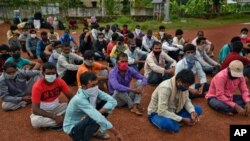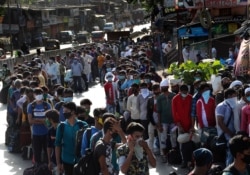Rearing cows is not the kind of work Rapani Bhatt was accustomed to doing – like many young people in his village in northern India, he quit the traditional occupation of farming to work in a city.
His life took a complete U-turn during the COVID-19 pandemic, though, when he lost his job at a call center in the city of Chandigarh. After returning to his village in Chamba Valley in the Himalayan state of Himachal Pradesh, he built a cattle shed, hoping dairy farming would yield a decent income.
“I am looking on it as a business opportunity because everything is shut in the city due to coronavirus. And we feel much safer at home,” he said, glancing at the widely separated houses and farms on the mountain slopes, where the virus is still not a threat.
Bhatt is among thousands trying to start life anew in the safer environment of villages after the pandemic triggered India’s biggest reverse migration.
In recent decades, more than 100 million people from India’s vast countryside sought city jobs, lured by higher wages working at construction sites, in factories, offices and hotels, or as security guards and drivers.
After cities were shuttered in late March and millions lost jobs, many faced the prospect of hunger as they were confined to small rooms during a stringent lockdown, while others made arduous journeys of hundreds of kilometers home, sometimes on foot, as all transport halted.
Their ordeal in the city and the fear of the pandemic has prompted migrants to try to rebuild their lives in their villages, where the virus is still not a threat.
In Jhandoor village in Himachal Pradesh, many are working in government-sponsored projects to build irrigation tanks, pathways or bridges across rivers to improve access to their homes or farms.
Some have started modest ventures to raise cattle and goats, while some are reclaiming forgotten patches of land with government assistance of up to $1,300 under a program aimed at creating opportunities for those returning to their home villages.
“With the money I got, I am leveling the hillside,” said Pervez Hussain, who was also laid off. “It was difficult to cultivate because of the slope, but now I will be able to grow vegetables and earn more money.”
Chamba district authorities hope returning migrants will boost the rural economy by looking beyond traditional farming of staple crops to starting horticulture projects that bring in higher income.
“For example, we persuaded them to grow lavender, which grows on the other side of the hill and hopefully we will see a major expansion soon,” said Vivek Bhatia, the district commissioner of Chamba.
“This way they can engage in some gainful self-employment and this could become the crux of rural development,” he said.
Bhatia said the loss of higher urban incomes by those returning can be offset by the lower cost of living in villages.
“Even though their earning may be less, their expenditure is low so their net earning here is much, much better. Secondly, they are closer to home,” he said.
Creating ways to earn a living for migrants who have lost jobs remains India’s biggest challenge as it grapples with the pandemic and a faltering economy. Last month the federal government launched a nationwide $6 billion program to expand a rural works program providing daily wage work in villages, but that may not be enough to alleviate the widespread distress of returning migrants.
That is why some states with huge numbers of migrants, such as Himachal Pradesh, are hoping to persuade them to start farm ventures to revive rural economies that suffered when young people left to work in cities.
The return of migrants could be a win-win for both migrants and villages in other ways too, according to Onkar Singh, a teacher who also lost his job in a nearby town.
“All these people bring back what they learned in cities, for example better hygiene standards. That will influence the elderly and the illiterate and help transform villages,” according to Singh, who has turned his hand to rearing animals.
However, village elder Dharam Chand advises that working on farms will be different from the migrant’s city jobs.
“They have to take their animals to graze early in the morning and plow their fields. It is hard work,” he said, adding, “They can’t sit and earn money here. They must be prepared to slog.”
They are doing it for now but it is not clear whether they will stay when the threat passes.
Bhatia said about half of one group of migrants seemed to want to return to cities when conditions improve, while the others preferred to stay.
“It is their will and their choice, so let’s see how it turns out,” he said.







